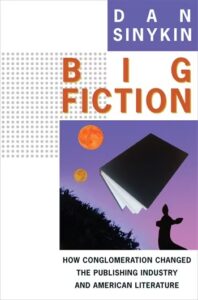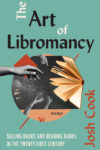
[Columbia University Press; 2023]
To some, it would appear we are in a golden age of literary production. A seemingly endless number of imprints exist, new ones emerging every day, that specialize in genres as specific as Christian self-help, wellness books approved by Gwyneth Paltrow, or simply titles from “exceptional writers deeply engaged with the world.” While the sheer number of imprints may give the impression of a healthy, thriving industry, the reality is that they are all owned by a handful of companies that, themselves, are just parts of international corporations. Random House, half of Penguin Random House—a company owned by a German corporation—has three hundred imprints on its own. Dan Sinykin’s Big Fiction is a refreshing attempt to consider how we got here by tracing the last six or seven decades of US fiction and its production. Sinykin, an associate professor of English at Emory University in Atlanta, has published on the broad topic of US fiction before. His first book, American Literature in the Long Downturn, argues that the rise of apocalyptic themes in contemporary US literature reflects the economic disparity in the postwar United States. Big Fiction takes an even broader scope, offering a theory to explain the way that corporate conglomeration changed the publishing industry and, in the process, “changed how and what we read—and how and what writers write.”
Though Big Fiction is likely to find a mostly academic audience, Sinykin’s writing invites any reader of US fiction. As a former bookseller, I appreciated seeing a scholar finally treat the aesthetic and material trends in the mass market fiction that sustains so much of the industry. In addition to his broad range of texts, Sinykin’s wide invitation involves his straightforward prose with plenty of narrative to pull you along. The introduction begins almost like a mystery or noir novel. Sinykin follows Andre Schiffrin, the former editorial director of the Random House imprint Pantheon, as he walks home after work. “It was a Monday in late February 1990, the coldest day of the year. . . . Wind blew down from the Hudson River, tousling his graying red hair, stinging his wide-set, mousy eyes. He shivered and pulled his overcoat tighter around himself, heading home to his wife. He had just been fired.” Big Fiction is full of anecdotes like this about major and minor figures in the grand story of conglomeration in US publishing, allowing readers of literary and genre fiction alike the chance to see how the sausage is made.
Sinykin contends that the academy needs to think more carefully about how literature is produced. “Our outsize attention to the author alone is a trick of history, the legacy of copyright: authors needed to be responsible for books if they were to collect royalties; lawyers needed someone on whom to lay the blame for libel.” In the age of editors, agents, and mass-marketing campaigns in publishing, Sinykin argues, it’s not exactly accurate to say that any novel can be attributed to a single name on the cover. You don’t have to agree with all of Sinykin’s conclusions to appreciate the value of this method as a critical intervention in the academy. The issue of authorship is as old as literature and literary studies. With The Odyssey and The Iliad, we got the Homeric questions. Then came Romantic theories of authorship, still influential in some areas of literary studies, which posited that each work of literature bore the mark of genius imparted on it by its gifted author. Roland Barthes rejected this idea in his 1967 essay, “The Death of the Author,” asserting that “writing is the destruction of every voice, of every point of origin” and refusing to recognize a connection between a work of literature and the identity of its author. Sinykin’s position on authorship is not as extreme as to deny any point of origin for a specific work. Instead, he focuses on the conditions under which literature is produced, the people, the companies, the laws, and the economic circumstances that made US literature what it is today. With more people working on each title, he argues, “authorship is social and distributed widely.”
In his approach, Sinykin is most like his historical materialist predecessor Mark McGurl. McGurl’s 2009 book The Program Era has its fingerprints all over Big Fiction. While Sinykin attends to the publishing industry, McGurl’s book considers the effects of the rise of the creative writing program in American universities after the Second World War. McGurl contends that the creative writing programs were the most impactful forces on modern American fiction, producing aesthetic trends that persist to the present day, including emphasis on the individual voice of the author, a heightened focus on the author’s personal experiences, and an appreciation for creativity as such. Romantic as this may sound, the centrality of the individual in each of these concepts, McGurl notes, is ironic for how much more collective the production of literature became over this period, be it in workshops or through the pressure on authors to resemble their predecessors in such programs. Like McGurl, Sinykin’s institutional analysis is an attempt to explain the rise in two genres, “literary genre” fiction and “autofiction.” Both McGurl and Sinykin agree that multiculturalism emerged as another force in the world of literary production and interpretation, but for Sinykin, it’s mostly smaller, independent presses that carry the mantle of multicultural literature. Autofiction and literary genre fiction are closer to the real object of his study: literature produced by an increasingly shrinking number of corporate publishers. Sinykin is careful not to be reductive—“[A]utofiction is not one thing, literary genre fiction is not one thing”—but gives us working definitions that allow us to understand his claims. Literary genre fiction uses tropes from both high literature and mass-market genre fiction. Autofiction, on the other hand, expects readers to understand characters in the novel to be representations of the authors themselves.
As in The Program Era, the G.I. Bill, which granted more Americans access to higher education than ever before, figures heavily in Big Fiction. This policy produced enough college graduates to sustain a profitable and diverse world of literary publishing in which privately-owned, independent presses thrived until about 1959, per Sinykin. He argues that the conglomerate era began in 1960, when a newspaper company, Times Mirror, acquired a mass market publishing house, New American Library. These conglomerates—massive corporations with subsidiaries across regions and industries—subjected literary production to the same market pressures that dictate the production of any other commodity. Agents and enterprising editors became as valuable as authors themselves for their ability to recognize, produce, and market bestsellers. The book tour was born. This trend has not slowed since it began in 1960, and there are fewer major publishing houses than ever before. “It’s still the conglomerate era. It is more the conglomerate era than ever,” Sinykin writes, going on to historicize the 2018 merger of Penguin and Random House and the more recent failed acquisition of Penguin Random House by Simon and Schuster. Conglomeration only seems to be accelerating, so we need to understand how it impacts what we read and how we read it.
Sinykin’s attention to the institutions of literary production is particularly valuable in his reading of Toni Morrison. “In 1967, when Toni Morrison entered the profession,” he notes, “about 95 percent of the fiction published by the big commercial houses was by white authors.” Enter Morrison, who started as a textbook editor for Random House before her promotion to trade editor at the New York City headquarters. Sinykin tells us that this promotion happened during a visit to that office by Bob Bernstein, then president of the house, who observed that “African-Americans were not just underrepresented in the business; they were practically nonexistent.” Sinykin notes that Morrison’s professional situation in New York was “fraught” even “within the house, where she had to contest entrenched white supremacy.” He also describes the external pressures Morrison felt from Black peers in the literary world, some of whom came to view her as a sellout. Morrison once received a letter from her friend Carole Parks, an editor at Black World magazine, who accused her of having “added to the myth that Black genius would languish unappreciated were it not for some white liberal or far-sighted individual like yourself.” These frustrations eventually pushed Morrison out of the industry, as an editor, at least. Sinykin notes how, in the preface to Beloved, Morrison says of the publishing industry that “leaving was a good idea. . . . My enthusiasm, shared by some, was muted by others, reflecting the indifferent sales figures.” This experience, according to Sinykin, provided valuable source material for Morrison as she wrote Beloved. Though he notes that it may be “on its face, a ludicrous claim” to call Beloved a novel about the publishing industry, when it’s really “about chain gangs and slave catchers and trauma,” Sinykin makes the case compellingly. Returning to her comments on publishing in the preface, Sinykin notes that quitting Random House allowed Morrison to feel “the shock of liberation that drew my thoughts to what free could mean.” He also draws parallels between Sethe, who “was coerced into complicity with racist writings” in making the ink that the novel’s villain, the schoolteacher, uses, and Morrison’s views on the work she did for Random House. Referring to Morrison’s response to Carole Parks, Sinykin notes that Morrison tried to refuse individual responsibility for what could and could not be published, saying she “wrote that she didn’t have a career, she just had work.” A recent review of the rejection letters that Morrison wrote during her time as a senior editor at Random House provide further evidence for her frustrations with what was commercially viable and the struggle to make radical, explicitly political Black literature marketable enough to continue publishing.
Whether or not you accept Sinykin’s claim that Beloved is a publishing novel, his more significant commentary on the book helps explain how a “high modernist neo-slave narrative” became a national bestseller, won major prizes, and landed on the reading lists of Barbara Bush and Oprah. Though Sinykin notes that Morrison used magical realism at points earlier in her career, he argues that Beloved deployed more conventions from contemporary genre fiction than any of Morrison’s prior works. For Sinykin, “deploying a ghost, a haunted house, terrifying violence, and trauma” was not only Morrison’s commentary on the after-effects of slavery, but her way of engaging the popular genre fiction and a horror craze throughout the 70s and 80s. Beloved, he argues, is one of the earliest examples of literary genre fiction, a genre that he says “[c]onglomeration . . . generated the incentives for” in being able to appeal to readers of both literary and genre fiction, to varying degrees. Through this lens, Beloved ceases to be a bestseller because it taught Americans something about themselves and the racism of American institutions. It’s a bestseller because Morrison made it read more like a bestseller, formally, appealing to the mainstream reading public’s taste for the violent fiction of writers like Stephen King.
Sinykin is not criticizing Morrison or any other authors of literary genre fiction—a tradition to which he attributes Umberto Eco, Paul Auster, A.S. Byatt, Denis Johnson, and, later Colson Whitehead—for deploying genre tropes to reach more readers. While Sinykin’s claims rely on the distinction of genre and literary fiction, his arguments tend to blur that distinction and he does not privilege one as a more legitimate object of study than the other. He writes extensively about the romance author Danielle Steel and horror writer Stephen King, reading their fiction in the context of the same forces of conglomeration that their more literary counterparts were subjected to. Sinykin’s reading of Morrison, for example, demonstrates how even novels that earn the highest literary praise do so by borrowing heavily from the distinctly “un-literary.” And, to be clear, he’s also not alleging that Morrison intentionally borrowed genre tropes to boost sales; he’s simply positing a connection between those sales and the use of conventions from more popular writing. This was simply the reality of the publishing world at the time, when “conglomerates rationalized business practices at trade houses, demanding certain rates of growth, demands that reverberated throughout the industry.” Sinykin does not deny that the business is uneven in how it exploits labor and from whom but encourages readings that highlight the common pressure felt by all American fiction writers—the need to generate value for shareholders.
With its focus on US fiction, and specifically the fiction produced by the biggest conglomerates, Big Fiction has some predictable blind spots, like writing in translation, nonfiction publishing, and poetry. But Sinykin’s materialist methods are transferrable to those fields that Big Fiction doesn’t reach. As a whole, the book paves the way for a more concrete form of literary criticism that is attentive to the world that produces literature without reproducing the generic distinctions that imprints and academics insist on. Surely, US fiction can’t be reduced to just autofiction or literary genre fiction, but acknowledging these genres as the product of the market forces in the publishing world is an important step for bridging the gap between literary studies and the material conditions of literary production.
Colin Lavery is a writer based in Chicago, where he is a mentor for the MA program for the Humanities at the University of Chicago. Recent awards include a Master’s Thesis prize from the Karla Scherer Center for American Studies and the Chicago Kent Justice Foundation Fellowship. His writing focuses on contemporary American literature, historical materialism, and speculative fiction.
This post may contain affiliate links.







